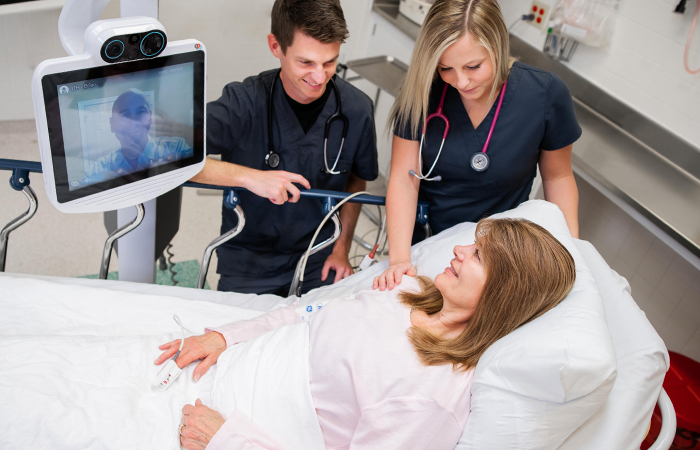
In the realm of emergency care, the utilization of telemedicine emerges as a transformative tool, revolutionizing how healthcare services are accessed and delivered. This comprehensive guide delves into the intricacies of telemedicine for emergency scenarios, shedding light on its significance and impact.
From exploring the innovative technologies employed to highlighting the benefits reaped, this discussion navigates through the critical aspects of integrating telemedicine into emergency care practices.
Telemedicine for Emergency Care
Telemedicine plays a crucial role in emergency care situations by enabling healthcare providers to remotely assess, diagnose, and treat patients in real-time, especially when immediate physical access to a healthcare facility is limited.
Telemedicine Technologies in Emergency Care
- Video Conferencing: Allows healthcare providers to conduct virtual consultations with patients, assess their condition, and provide medical advice.
- Remote Monitoring Devices: Enable healthcare professionals to remotely monitor vital signs and other health parameters of patients in real-time.
- Mobile Health Apps: Provide patients with access to healthcare services, such as scheduling appointments, accessing medical records, and receiving medical advice.
Benefits of Telemedicine for Emergency Care
- Improved Access to Care: Telemedicine helps bridge the gap between patients and healthcare providers, especially in remote or underserved areas.
- Reduced Response Time: By enabling quick virtual consultations, telemedicine can expedite the delivery of emergency care to patients in critical conditions.
- Cost-Effective: Utilizing telemedicine for emergency care can reduce healthcare costs associated with unnecessary emergency room visits and hospital admissions.
Importance of Telemedicine in Emergency Care

Telemedicine plays a crucial role in enhancing the delivery of emergency care services by bridging the gap between healthcare providers and patients, especially in remote or underserved areas. This innovative approach leverages technology to connect patients with medical professionals quickly, efficiently, and effectively during emergencies.
Improved Access to Emergency Care Services
Telemedicine significantly improves access to emergency care services by enabling patients to connect with healthcare providers remotely, regardless of their geographical location. This is particularly beneficial for individuals living in rural or isolated areas where access to traditional emergency care facilities may be limited. Through telemedicine, patients can receive timely medical assessment, diagnosis, and treatment, ultimately improving health outcomes and reducing the risk of complications.
Remote Diagnosis and Treatment during Emergencies
Telemedicine allows healthcare providers to remotely diagnose and treat patients during emergencies, providing timely medical intervention and guidance when physical access to a healthcare facility is challenging. Through video consultations, medical professionals can assess patients’ symptoms, prescribe medications, and recommend appropriate treatment strategies, ensuring that individuals receive the care they need promptly. This remote approach not only enhances the efficiency of emergency care delivery but also minimizes the need for unnecessary hospital visits, reducing healthcare costs and optimizing resource allocation.
Reducing Response Times in Emergency Situations
One of the most significant impacts of telemedicine on emergency care is the reduction of response times in critical situations. By connecting patients with healthcare providers virtually, telemedicine enables swift assessment and triage, allowing medical professionals to initiate life-saving interventions promptly. This rapid response can be particularly critical in emergencies such as heart attacks, strokes, or trauma, where timely medical attention is crucial for positive outcomes.
Through telemedicine, emergency response teams can coordinate effectively, communicate efficiently, and deliver care expeditiously, ultimately saving lives and improving patient survival rates.
Telemedicine Tools for Emergency Care
Telemedicine tools play a crucial role in providing timely and efficient emergency care to patients. These tools enable healthcare providers to remotely assess and treat patients in emergency situations, reducing response times and improving patient outcomes.
Essential Tools and Equipment
- Video Conferencing Platforms: Allow healthcare providers to conduct virtual consultations with patients and other medical professionals in real-time.
- Digital Stethoscopes: Enable providers to listen to a patient’s heart and lung sounds remotely, helping in diagnosing respiratory and cardiac conditions.
- High-Resolution Cameras: Provide clear visuals of wounds, rashes, or other physical symptoms for accurate assessment and treatment planning.
- Remote Monitoring Devices: Track vital signs such as blood pressure, heart rate, and oxygen levels, allowing for continuous patient monitoring.
- Electronic Health Record Systems: Access patient medical history, test results, and medication information for informed decision-making during emergencies.
Utilization of Tools in Emergency Telemedicine Consultations
- Healthcare providers can use video conferencing platforms to assess a patient’s condition, provide initial triage, and determine the urgency of care needed.
- Digital stethoscopes help providers listen to heart and lung sounds remotely, assisting in diagnosing respiratory issues like pneumonia or heart conditions like arrhythmias.
- High-resolution cameras allow for close-up views of injuries or symptoms, aiding in accurate diagnosis and treatment recommendations.
- Remote monitoring devices enable continuous tracking of vital signs, alerting providers to any sudden changes that may require immediate intervention.
- Electronic health record systems provide access to critical patient information, ensuring continuity of care and informed decision-making during emergency consultations.
Effectiveness of Telemedicine Tools vs. Traditional Emergency Care Equipment
Telemedicine tools offer the advantage of remote access and real-time communication, allowing healthcare providers to deliver timely care even in remote or underserved areas.
While traditional emergency care equipment may offer hands-on assessment capabilities, telemedicine tools provide a valuable alternative in situations where immediate in-person care is not feasible.
The use of telemedicine tools has been shown to reduce unnecessary emergency room visits, decrease response times, and improve patient satisfaction in emergency care settings.
Challenges and Limitations of Telemedicine in Emergency Care

Telemedicine in emergency care comes with its own set of challenges and limitations that need to be addressed to ensure optimal efficiency and effectiveness in providing remote medical assistance.
Connectivity Issues
One of the most common challenges faced in telemedicine for emergency care is poor connectivity. In emergency situations, where every second counts, any disruption in internet connection can hinder the ability to communicate effectively with healthcare providers and transmit vital information.
Lack of Physical Examination
Telemedicine technology has its limitations when it comes to conducting a physical examination of patients. Certain emergency medical situations require hands-on assessment to accurately diagnose and treat the patient, which can be challenging through a virtual platform.
Technical Glitches
Technical glitches such as audio or video lag, software malfunctions, or hardware failures can impede the smooth operation of telemedicine in emergency care. These issues can lead to delays in providing timely medical assistance to patients in critical conditions.
Limited Access to Specialized Care
Despite the advancements in telemedicine technology, access to specialized care in certain emergency situations remains limited. Not all healthcare facilities are equipped with the necessary tools or expertise to handle complex medical emergencies remotely.
Strategies to Overcome Challenges
To improve the efficiency of telemedicine in emergency care, healthcare providers can implement strategies such as regular training sessions for staff to address technical issues, ensuring backup communication methods in case of connectivity failures, and establishing protocols for when physical examination is required in emergency situations.
Emergency Care Protocols and Telemedicine
Telemedicine plays a crucial role in enhancing emergency care protocols by providing timely access to healthcare professionals, especially in critical situations. This integration ensures that patients receive the necessary medical attention promptly, even in remote locations or when traditional healthcare facilities are overwhelmed.
Initiating Telemedicine Consultations during Emergencies
- Healthcare providers initiate telemedicine consultations by assessing the patient’s condition through video calls, phone calls, or messaging platforms.
- Upon evaluating the patient’s symptoms and medical history, the healthcare provider can determine the appropriate course of action, whether it involves providing immediate guidance, scheduling an in-person visit, or coordinating emergency services.
- In emergency situations, telemedicine allows healthcare providers to triage patients efficiently, ensuring that those in critical condition receive priority care while others are directed to appropriate levels of care based on their needs.
Ensuring Patient Safety and Effective Care Delivery through Telemedicine
- Healthcare providers follow established protocols and guidelines to ensure patient safety during telemedicine consultations, including verifying patient identity, obtaining informed consent, and maintaining confidentiality of medical information.
- Through telemedicine, healthcare providers can collaborate with emergency response teams, specialists, and other healthcare professionals to facilitate coordinated care and decision-making, leading to better outcomes for patients.
- Continuous monitoring and follow-up care are essential components of telemedicine in emergency situations, allowing healthcare providers to track patient progress, adjust treatment plans as needed, and provide ongoing support to ensure optimal recovery.
As we wrap up this exploration of telemedicine for emergency care, it becomes evident that this evolving technology holds immense potential in reshaping the landscape of healthcare delivery. By bridging gaps, enhancing efficiency, and ensuring prompt responses, telemedicine stands as a beacon of hope in emergency situations.
Essential FAQs
What are some common challenges faced in implementing telemedicine for emergency care?
Common challenges include issues with connectivity, data security concerns, and the need for specialized training for healthcare providers.
How does telemedicine integrate with existing emergency care protocols?
Telemedicine seamlessly integrates by following established protocols for emergency response while adding the dimension of remote consultation and diagnosis.
What are some key tools required for telemedicine in emergency care?
Essential tools include video conferencing software, medical peripherals for remote examination, and secure data transmission systems.





